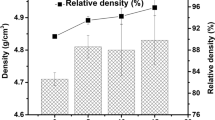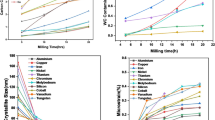Abstract
Sodium tungsten bronze powders were synthesized by thermal reduction of a gas/melt system at high temperature. Samples having a cubic structure with different compositions were prepared. The initial melt included Na2WO4, WO3 and 10–40% mol. NaCl while the reducing gas was hydrogen at 750 °C. An original mechanism of controlling the powders size and distribution was suggested and discussed. A quantitative novel and simple method to determine the bronze composition based on TGA data was developed. An increase in the NaCl content led to a decrease of the crystals size and improved the powder uniformity. Fine powders, in the 2–5 μm size range, were synthesized from melt with 40% mol of NaCl. The stoichiometry parameter x of the obtained bronzes ranged from 0.8 to 0.92. An excellent agreement between x values determined by the classical XRD route and the proposed TGA method was demonstrated.







Similar content being viewed by others
References
Philipp J, Schwebel P (1879) Ber Deutsch Chem Ges 12:2234
Edwards PP, Rao CNR (1985) The metallic and nonmetallic states of matter. Taylor & Francis
Hagenmuller P (1971) In: Progress in solid state chemistry, vol 5. Oxford Pergamon, p 71
Sienko MJ (1963) In: Non-stoichiometric compounds. Advances in Chemistry Series, American Chemical Society, p 224
Ribnick AS, Post B, Banks E (1963) In: Non-stoichiometric compounds. Advances in Chemistry Series, American Chemical Society, p 246
Randin JP (1974) J Chem Educ 51(1):32
Brown BW, Banks E (1954) J Am Chem Soc 76:963
Barabushkin AN, Kaliev KA, Vakarin SV, Dokuchaev LYa, Butrimov VV, Aksent’ev AG (1988) U.S.S.R., SU 1425531 A1 19880923
Ozerov RP (1954) Uspekhi Khimii 24:951
Shanks HR (1972) J Crystal Growth 13/14:433
Bartha L, Kiss AB, Szalay T (1995) Int J Refractory Metals & Hard Mater 13(1–3):77
Shurdumov BK (2001) Izvestiya Vysshikh Uchebnykh Zavedenii, Khimiya i Khimicheskaya Tekhnologiya 44(6):152
Shurdumov BK, Shurdumov GK, Kuchukova MA (1999) RU 2138445C1
Salje E, Hatami H (1973) Z Allg Chem 396:267
Zhu YT, Manthiram A (1994) J Solid Sate Chem 110:187
Fan R, Chen XH, Gui Z, Li SY, Chen ZY (2001) Mat Let 49:14
Dickens PG, Whittingham MS (1965) M S Trans Faraday Soc 61:1226
Weber MF, Bevolo AJ, Shanks HR, Danielson GC (1981) J Electrochem Soc 128(5):996
Bevolo AJ, Weber MF, Shanks HR, Danielson GC (1981) J Electrochem Soc 128(5):1004
Shanks HR, Bevolo AJ, Danielson GC, Neker MF (1980) Fuel cell oxygen electrode, U.S. Pat. Appl. US 18211
Binder H, Knoedler R, Koehling A, Sandstede G (1977) Device for the continuous determination of carbon monoxide content in air, U.S. Pat. Appl. US 580532
Wechter MA, Hahn PB, Ebert GM, Montoya PR, Voigt AF (1972) Anal Chem 45:7
Hahn PB, Wechter MA, Jhonson DC, Voigt AF (1973) Anal Chem 45:7
Whittimgham MS, Huggins RA (1971) J chem Phys 54:1
van Duyn D (1942) Recl Rtav Chim Pays-Bas, Belg 61:661
Cleaver B, Koronaios P (1994) J Chem Eng Data 39(4):848
Khakulov ZL, Mohosoev MV, Vorozgbit VU, Shurdumov GK (1983) Khimia I Tekhnol Molibdena I Vol’frama, Nal’chik, USSR 7:23
Vorozgbit VU, Shurdumov GK, Kodzokov KhA (1979) Khimia I Tekhnol Molibdena I Vol’frama, Nal’chik, USSR 5:79
Shurdumov BK (1976) Khimia I Tekhnol Molibdena I Vol’frama, Nal’chik, USSR 3:175
Hoermann F (1928) Zs Anorgan Allgem Chem 177(2–3):145; Tropov NA, Barzakovsky VP, Lapin VV, Kurtseva NN (1969) Phase diagrams of silicates systems. Academy of Science USSR, “Nauka”, Leningrad, p 628
Acknowledgements
The investigations were supported by the Technion’s fund for the promotion of research and in part by a joint grant from the Center for Adsorption in Science of the Ministry of Immigrant Absorption State of Israel and the Committee for Planning and Budgeting of the Council for Higher Education under the framework of the KAMEA Program.
Author information
Authors and Affiliations
Corresponding author
Rights and permissions
About this article
Cite this article
Mann, M., Shter, G.E., Reisner, G.M. et al. Synthesis of tungsten bronze powder and determination of its composition. J Mater Sci 42, 1010–1018 (2007). https://doi.org/10.1007/s10853-006-1384-x
Received:
Accepted:
Published:
Issue Date:
DOI: https://doi.org/10.1007/s10853-006-1384-x




